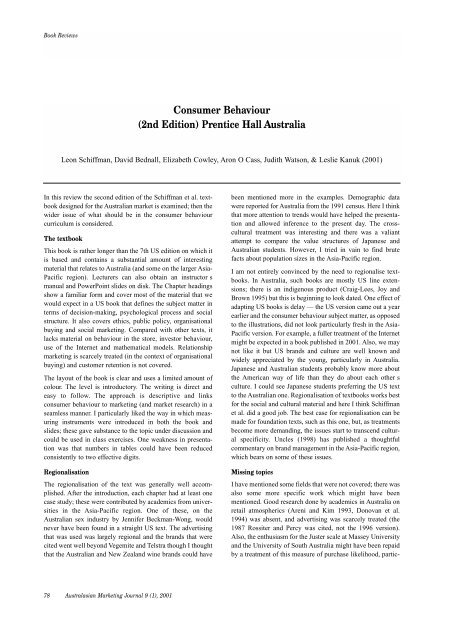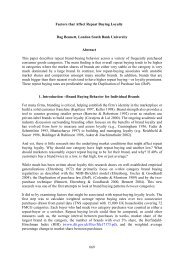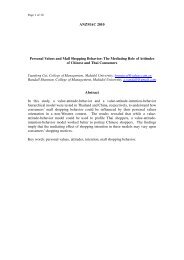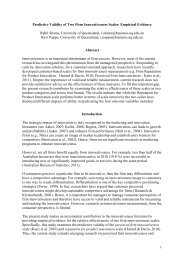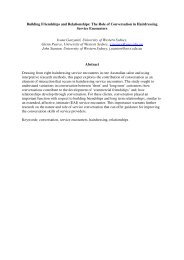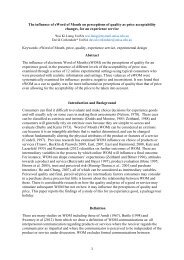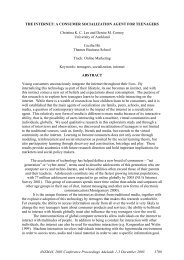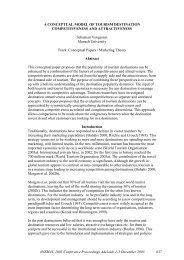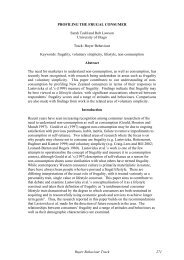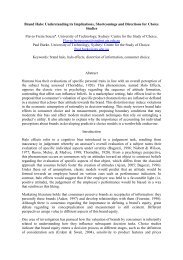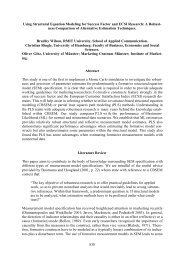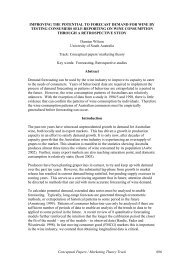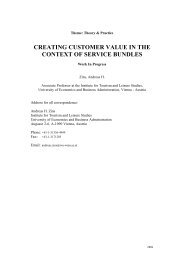amj Australasian Marketing Journal - ANZMAC
amj Australasian Marketing Journal - ANZMAC
amj Australasian Marketing Journal - ANZMAC
You also want an ePaper? Increase the reach of your titles
YUMPU automatically turns print PDFs into web optimized ePapers that Google loves.
Book Reviews<br />
In this review the second edition of the Schiffman et al. textbook<br />
designed for the Australian market is examined; then the<br />
wider issue of what should be in the consumer behaviour<br />
curriculum is considered.<br />
The textbook<br />
This book is rather longer than the 7th US edition on which it<br />
is based and contains a substantial amount of interesting<br />
material that relates to Australia (and some on the larger Asia-<br />
Pacific region). Lecturers can also obtain an instructor s<br />
manual and PowerPoint slides on disk. The Chapter headings<br />
show a familiar form and cover most of the material that we<br />
would expect in a US book that defines the subject matter in<br />
terms of decision-making, psychological process and social<br />
structure. It also covers ethics, public policy, organisational<br />
buying and social marketing. Compared with other texts, it<br />
lacks material on behaviour in the store, investor behaviour,<br />
use of the Internet and mathematical models. Relationship<br />
marketing is scarcely treated (in the context of organisational<br />
buying) and customer retention is not covered.<br />
The layout of the book is clear and uses a limited amount of<br />
colour. The level is introductory. The writing is direct and<br />
easy to follow. The approach is descriptive and links<br />
consumer behaviour to marketing (and market research) in a<br />
seamless manner. I particularly liked the way in which measuring<br />
instruments were introduced in both the book and<br />
slides; these gave substance to the topic under discussion and<br />
could be used in class exercises. One weakness in presentation<br />
was that numbers in tables could have been reduced<br />
consistently to two effective digits.<br />
Regionalisation<br />
The regionalisation of the text was generally well accomplished.<br />
After the introduction, each chapter had at least one<br />
case study; these were contributed by academics from universities<br />
in the Asia-Pacific region. One of these, on the<br />
Australian sex industry by Jennifer Beckman-Wong, would<br />
never have been found in a straight US text. The advertising<br />
that was used was largely regional and the brands that were<br />
cited went well beyond Vegemite and Telstra though I thought<br />
that the Australian and New Zealand wine brands could have<br />
78 <strong>Australasian</strong> <strong>Marketing</strong> <strong>Journal</strong> 9 (1), 2001<br />
Consumer Behaviour<br />
(2nd Edition) Prentice Hall Australia<br />
Leon Schiffman, David Bednall, Elizabeth Cowley, Aron O Cass, Judith Watson, & Leslie Kanuk (2001)<br />
been mentioned more in the examples. Demographic data<br />
were reported for Australia from the 1991 census. Here I think<br />
that more attention to trends would have helped the presentation<br />
and allowed inference to the present day. The crosscultural<br />
treatment was interesting and there was a valiant<br />
attempt to compare the value structures of Japanese and<br />
Australian students. However, I tried in vain to find brute<br />
facts about population sizes in the Asia-Pacific region.<br />
I am not entirely convinced by the need to regionalise textbooks.<br />
In Australia, such books are mostly US line extensions;<br />
there is an indigenous product (Craig-Lees, Joy and<br />
Brown 1995) but this is beginning to look dated. One effect of<br />
adapting US books is delay — the US version came out a year<br />
earlier and the consumer behaviour subject matter, as opposed<br />
to the illustrations, did not look particularly fresh in the Asia-<br />
Pacific version. For example, a fuller treatment of the Internet<br />
might be expected in a book published in 2001. Also, we may<br />
not like it but US brands and culture are well known and<br />
widely appreciated by the young, particularly in Australia.<br />
Japanese and Australian students probably know more about<br />
the American way of life than they do about each other s<br />
culture. I could see Japanese students preferring the US text<br />
to the Australian one. Regionalisation of textbooks works best<br />
for the social and cultural material and here I think Schiffman<br />
et al. did a good job. The best case for regionalisation can be<br />
made for foundation texts, such as this one, but, as treatments<br />
become more demanding, the issues start to transcend cultural<br />
specificity. Uncles (1998) has published a thoughtful<br />
commentary on brand management in the Asia-Pacific region,<br />
which bears on some of these issues.<br />
Missing topics<br />
I have mentioned some fields that were not covered; there was<br />
also some more specific work which might have been<br />
mentioned. Good research done by academics in Australia on<br />
retail atmospherics (Areni and Kim 1993, Donovan et al.<br />
1994) was absent, and advertising was scarcely treated (the<br />
1987 Rossiter and Percy was cited, not the 1996 version).<br />
Also, the enthusiasm for the Juster scale at Massey University<br />
and the University of South Australia might have been repaid<br />
by a treatment of this measure of purchase likelihood, partic-


